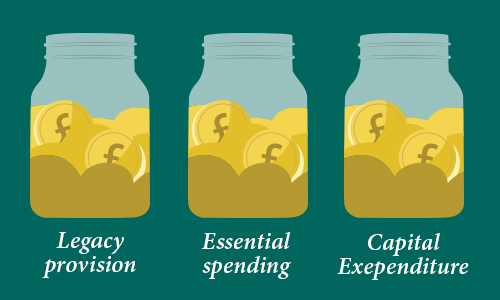A solution for when a one size fits all approach is not the answer. Introducing 'multi-pot' investing.
When the goal is saving for retirement, the high-level investment strategy is a simple one; growth. Those accumulating wealth for their later years recognise that it is all about increasing the value of investments over time to generate a sum that can support future income needs.
But when the time comes to start to use a pension fund to generate an income (decumulation), those choosing to remain invested should revisit their investment strategy. The introduction of Pensions Freedom in 2015 has provided retirees with a great deal more flexibility in utilising pension investments. One consequence of this is a growing number of people electing to keep some or all of their money invested for as long as possible, choosing to draw down investment income and capital rather than the alternative of buying an annuity.
This piece does not aim to explore the relative merits of retaining and drawing down on a pension fund versus buying an annuity but instead to look at an interesting way of designing an investment strategy for those who choose the former.
I suspect your first thought might be surely this is simple. The goal now should be to maximise income. Unfortunately, that simplifies matters somewhat and does not recognise that circumstances may not be that clear cut when entering retirement. Objectives can be more complex and include more than just an income to meet spending needs.
Multi-pot investing is a concept that supports the notion that investors in retirement can have a variety of requirements. Let's look at some examples:
- Meeting essential spending needs when regular income ceases
- Planning for a future capital expenditure
- Covering discretionary spending
- Providing for a legacy
The important thing to acknowledge is that each of these objectives could have a different time horizon. For example, provision for a legacy will be in play for the investor's lifetime, while a planned capital expenditure is likely to have a more specific timescale, say 10 years. This is very significant in investment terms as it directly influences decisions over risk, which can dictate what type of portfolio is most suitable. For example, a pot allocated to providing a future legacy will not be required to support an income, so it is more likely that any portfolio will include a higher weighting towards equities with a growth bias, say smaller companies, for example.
Multi-pot investing essentially allows investors to divide a pension plan's value into a series of 'pots', each associated with a different planning objective. An investment adviser can then work with a client to determine what level of risk they are willing to accept for each pot and deploy an appropriate portfolio. So rather than adopting a one-size-fits-all approach, the overall retirement plan is broken down into a series of mini-plans, each with its own investment strategy.
An important benefit of a multi-pot approach is that it allows for some of the pension plan to be invested over a longer period, with a focus on growth. This can help mitigate one of the risks associated with drawing your pension: longevity risk, which is the possibility that your savings are used up too quickly leaving no capital to provide for continued income. Having the option to hold a pot linked to a growth portfolio can be a sensible strategy.
Finally, as with any investment regular reviews are important. In the case of a multi-pot arrangement, you and your adviser will want to ensure that each pot remains relevant and that the chosen investment portfolios are performing in line with expectations.
Important information
The contents of this article are for information purposes only and do not constitute advice or a personal recommendation. Investors are advised to seek professional advice before entering into any investment decisions. Please also note the value of investments and the income you get from them may fall as well as rise and there is no certainty that you will get back the amount of your original investment. You should also be aware that past performance may not be a reliable guide to future. performance.
How would you like to share this?


